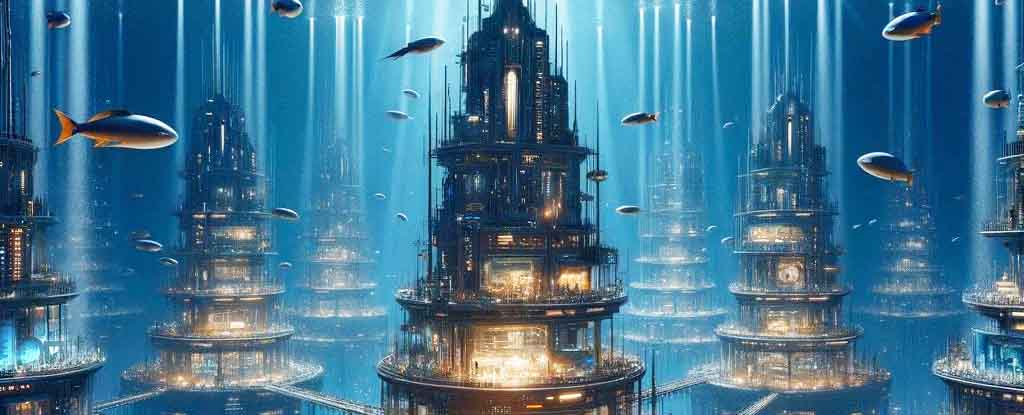

Water is a reference to the flow of the collective unconsciousness (grids) - that which creates realities in which we learn through experience..
Water Deities refers to Gods and Goddesses (extraterrestrials) who allegedly came from the sea, created a biogenetic experiment called Humans, then returned to the sea - implying subterranean bases and USOs.
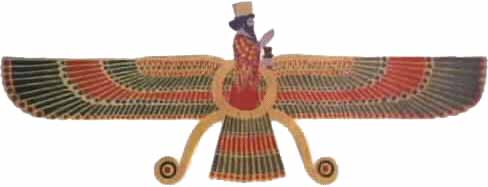
Zoroaster (depicted) as Aster (Asher, Star) above the Omphalos.
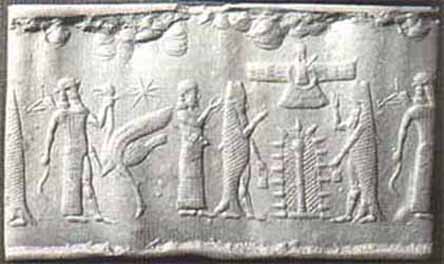
Sumerian Gods - Anunnaki
Enki, Ea, and Enlil thought to live in the 'Apsu' or submarine palace.
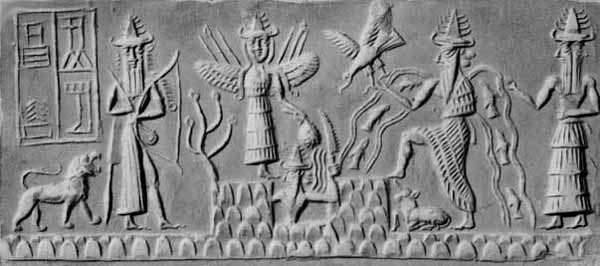
Sumerian Gods Allegedly Create a Biogenetic Experiment called Humans
The Sumerians were the world's first civilization, emerging in Mesopotamia over 6,000 years ago to develop agriculture, the wheel, mathematics, and a written language. According to their text, they attribute their knowledge to divine teachers who came down from the heavens known as the Anunnaki who instructed humanity in various arts and sciences.


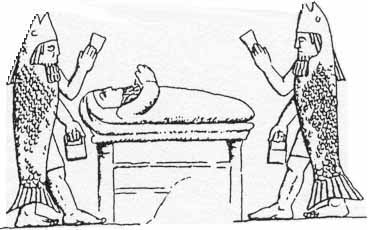
Oannes was the first bringer of knowledge especially in mathematics and science. Legend has it that during the day he would be among the people as their teacher and at night would disappear into the water.
Oannes could shape-shift into different iterations of himself in each pantheon of gods and goddesses. They all had the same agendas based on the same algorithm in the Simulation of Reality.
As extraterrestrials they came from the sky in a UFO or through a portal - to teach humanity.
As part of the Sumerian pantheon Oannes - by any name - wore different head-dresses. He can be recognized wearing an arm band, a wrist device used for communication, teleportation, invisibility, shape-shifting, more - and carrying the identical water bucket, or container, or 'pocketbook' which carried the seeds of creation (bloodline).
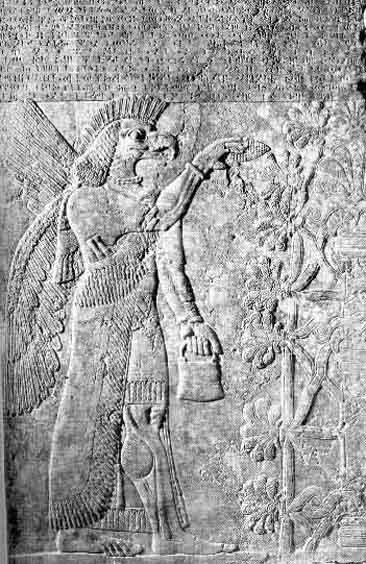
Gods and Bloodlines
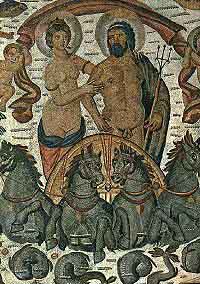
In ancient Greek mythology, Amphitrite (not to be confused with Aphrodite) was a sea-goddess. Under the influence of the Olympian pantheon, she became merely the consort of Poseidon, and was further diminished by poets to a symbolic representation of the sea. In Roman mythology, the consort of Neptune, a comparatively minor figure, was Salacia.
Amphitrite was a daughter of Nereus and Doris - and thus a Nereid - according to Hesiod's Theogony, but of Oceanus and Tethys and thus an Oceanid according to Apollodorus, who actually lists her among both the Nereids and the Oceanids. Amphitrite's offspring included seals and dolphins. By her, Poseidon had a son, Triton, and a daughter, Rhode (if this Rhode was not actually fathered by Poseidon on Halia or was not the daughter of Asopus as others claim). Apollodorus (3.15.4) also mentions a daughter of Poseidon and Amphitrite named Benthesikyme. Amphitrite is not fully personified in the Homeric epics: "out on the open sea, in Amphitrite's breakers" (Odyssey iii.101); she shares her Homeric epithet Halosydne ("sea-nourished") with Thetis: in some sense the sea-nymphs are doublets.
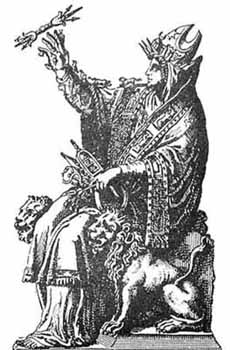
The mitre on the head of the goddess Cybele is striking similarity to the 'fish head' of the God Dagon. The Great Goddess of Asia Minor is the oldest true Goddess known, predating the Goddesses of the Sumerian and Egyptians by at least 5,000 years. Cybele was worshipped in Rome and was also called the "Magna Mater", or the great queen mother goddess, which evolved into Catholic Mariology.
�Originally a Phrygian goddess, Cybele (sometimes given the etymology "she of the hair" if her name is Greek, not Phrygian, but more widely considered of Luwian origin, from Kubaba) (Roman equivalent: Magna Mater or 'Great Mother') was a manifestation of the Earth Mother goddess who was worshipped in Anatolia from Neolithic times. Like Gaia or her Minoan equivalent Rhea, Cybele embodies the fertile earth, a goddess of caverns and mountains, walls and fortresses, nature, wild animals (especially lions and bees).
Her title 'Mistress of the Animals' (potnia theron) which is also associated with the Minoan Great Mother, alludes to her ancient Paleolithic roots. She is a life-death-rebirth deity. Her consort, whose cult was introduced , is her son Attis.Cybele was supposed to have been born on Mount Ida in Asia Minor; this is the source of her epithet Idaea.
Cybele's most ecstatic followers were males who ritually castrated themselves, after which they were given women's clothing and assumed female identities, who were referred to by contemporary commentator Kallimachos in the feminine Gallai , and who other contemporary commetators in ancient Greece and Rome reffered to as Gallos or Galli. Her Priestesses led the people in orgiastic ceremonies with wild music, drumming and dancing and drink. She was associated with the mystery religion concerning her son, Attis, who was castrated and resurrected. The dactyls were part of her retinue. Other followers of Cybele, Phrygian kurbantes or Corybantes expressed her ecstatic and orgiastic cult in music especially drumming, clashing of shields and spears, dancing, singing, shouts, all at night. Atalanta and Hippomenes were turned into lions by Cybele after having sex in one of her temples.
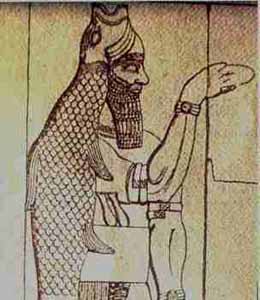

Dagon was the god of the Philistines. The idol was represented in the combination of both man and fish. The name 'Dagon' is derived from 'dag' which means 'fish'. Although there was a deep affection from Dagon's worshippers to their deity, the symbol of a fish in human form was really meant to represent fertility and the vivifying powers of nature and reproduction. His name is a lot like 'Dogon'.
Dagon was a major northwest Semitic god, the god of grain and agriculture according to the few sources to speak of the matter, worshipped by the early Amorites, by the people of Ebla, by the people of Ugarit and a chief god (perhaps the chief god) of the Biblical Philistines. His name appears in Hebrew as (in modern transcription Dagon, Tiberian Hebrew), in Ugaritic as dgn (probably vocalized as Dagnu), and in Akkadian as Dagana, Daguna usually rendered in English translations as Dagan.
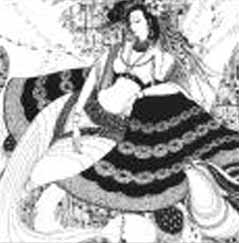
Fuxi or Fu Hsi
Ancient painting of Nuwa and Fuxi

unearthed in Xinjiang.
The Chinese have maintained that their civilization was founded by amphibious beings that had a man's head and a fish tail. The entity, named Fuxi, has been depicted as both male or female. The date traditionally ascribed to him is 3,322BC. In Chinese mythology, Fu Xi or Fu Hsi was the first of the mythical Three Sovereigns of ancient China. He is a culture hero reputed to be the inventor of writing, fishing, and trapping.
Fu Xi was born on the lower-middle reaches of the Yellow River in a place called Chengji (possibly modern Lantian, Shaanxi or Tianshui, Gansu). According to legend the land was swept by a great flood and only Fuxi and his sister Nuwa survived. The retired to Kunlun Mountain where they prayed for a sign from the Emperor of Heaven. The divine being approved their union and the siblings set about procreating the human race. Fu Xi then came to rule over his decedents although reports of his long reign vary between sources from 115 years (2852 - 2737 BCE) to 116 years (2952-2836 BCE). He lived for 197 years altogether and died at a place called Chen (modern Huaiyang, Henan) where his mausoleum can still be found.
During the time of his predecessor Nuwa (who according to some sources was also his wife and/or sister) society was matriarchal and primitive. Childbirth was seen to be miraculous not requiring the participation of the male and children only knew their mothers. As the reproductive process became better understood ancient Chinese society moved towards a patriarchal system and Fu Xi assumed primary importance.
Fu Hsi taught his subjects to cook, to fish with nets, and to hunt with weapons made of iron. He instituted marriage and offered the first open air sacrifices to heaven. A stone tablet, dated 160 CE shows Fu Hsi with Nuwa, who was both his wife and his sister.
Traditionally, Fu Hsi is considered the originator of the I Ching (also known as the Yi Jing or Zhou Yi), which work is attributed to his reading of the He Map (or the Yellow River Map). By this tradition, Fu Hsi had the arrangement of the trigrams of the I Ching revealed to him supernaturally. This arrangement precedes the compilation of the I Ching during the Zhou dynasty. Fu Hsi is said to have discovered the arrangement in markings on the back of a mythical dragon-horse (sometimes said to be a turtle) that emerged from the river Luo. This discovery is also said to have been the origin of calligraphy. Fu Hsi is also credited with the invention of the Guqin, together with Shennong and Huang Di.
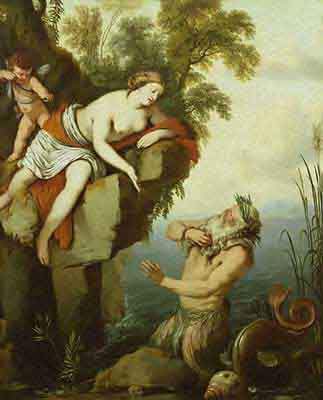
Glaucus and Scylla
In Greek mythology, Glaucus ("shiny," "bright" or "bluish-green") was the name of several different figures, including one God. These figures are sometimes referred to as Glaukos or Glacus. Glaucus was a Greek sea-god.
According to Ovid, Glaucus began life as a mortal fisherman living in the Boeotian city of Anthedon. He discovered by accident a magical herb which could bring the fish he caught back to life, and decided to try eating it. The herb made him immortal, but also caused him to grow fins instead of arms and a fish's tail instead of legs, forcing him to dwell forever in the sea. Glaucus was initially upset by this side-effect, but Oceanus and Tethys received him well and he was quickly accepted among the deities of the sea, learning from them the art of prophecy.
Glaucus fell in love with the beautiful nymph Scylla, but she was appalled by his fish-like features and fled onto land when he tried to approach her. He asked the witch Circe for a potion to make Scylla fall in love with him, but Circe fell in love with him. She tried to win his heart with her most passionate and loving words, telling him to scorn Scylla and stay with her. But he replied that trees would grow on the ocean floor and seaweed would grow on the highest mountain before he would stop loving Scylla. In her anger, Circe poisoned the pool where Scylla bathed, transforming her into a terrible monster with twelve feet and six heads.
In Euripides' play Orestes, Glaucus was a son of Nereus and says that he assisted Menelaus on his homeward journey with good advice. He also helped the Argonauts. It was believed that he commonly came to the rescue of sailors in storms, having once been one himself.
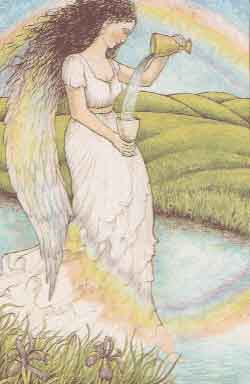
Iris
In Greek mythology, Iris was the daughter of Thaumas and the ocean nymph Electra and one of the Oceanids (according to Hesiod), the personification of the rainbow and messenger of the gods. As the rainbow unites Earth and heaven, Iris is the messenger of the gods to men; in this capacity she is mentioned frequently in the Iliad, but never in the Odyssey, where Hermes takes her place.
Iris is represented as a youthful virgin, with wings of gold, who hurries with the swiftness of the wind from one end of the world to the other, into the depths of the sea and the underworld. She is especially the messenger of Hera, and is associated with Hermes, whose caduceus or staff she often holds.
By command of Zeus she carries in an ewer water from the Styx, with which she puts to sleep all who perjure themselves. Her attributes are the caduceus and a vase. She is also represented as supplying the clouds with the water needed to deluge the world. Iris is the personal messenger of Hera, queen of the gods and is Hera's go-between from Mount Olympus to the mortal world.The word iridescence is derived in part from the name of this goddess.
Many were the progeny of the sea; some of them we shall meet later in saga, for example the Graeae, Gorgons, and the Harpies.
Progeny of the sea often appear grotesque or fantastic. At this point, however, we single out only Iris [eye'ris], a beautiful descendant of Pontus and Gaia.
Iris, fleet-footed and winged, is the lovely goddess of the rainbow, the meaning of her name. She is also (like Hermes) a messenger of the gods.
Aristotle's friend, Eudoxus, visited Egypt and returned claiming that the Egyptians had a tradition that one of their gods, Osiris or Ra (from Ray of Light), could not walk because his legs had grown together.
Osiris was the god of the Dead. He is a god of agriculture, for his death and resurrection are like those of a seed, cast in to the dark Earth, motionless. New life breaks through its husk to push its way to the surface of the earth as a green shoot. He became one of the most important of Egyptian gods because he symbolized the triumph of life over death.
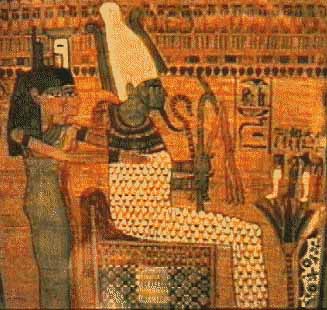
this image depicts his mummified form looking like the scales of a fish.
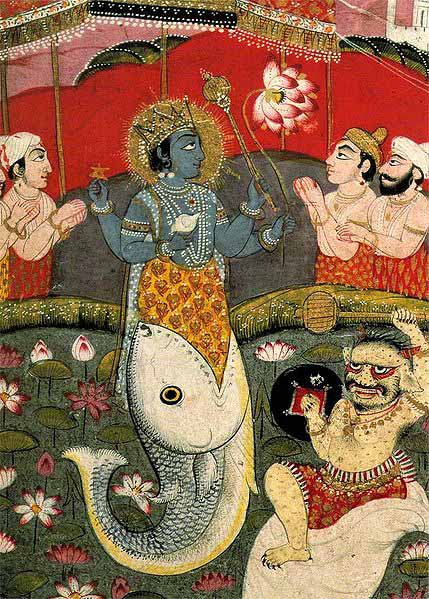
Matsya the Fish appeared in the Satya Yuga and represents beginning of life.
The Fish Incarnation is the first incarnation of Vishnu. Lord Vishnu takes the form of a fish in order to retrieve the Vedas from the demon Hayagriva, who stole them from Lord Brahma. Without the Vedas, Creation of the Universe cannot take place. He slayed the demon Hayagriva, recovered the Vedas, and also saved the pious king Satyavrata from the deluge so that life and religion can be preserved for the next cycle of Creation.
According to legend, the king Manu was washing his hands in a river when a little fish swam into his hands and begged him to save it. He put it in a jar, which it soon outgrew; he successively moved it to a tank, a river and then the ocean. The fish then warned him that a Great Flood would occur in a week that would destroy all life. Manu therefore built a boat which the fish towed to a mountaintop when the flood came, and thus he survived along with some "seeds of life" to re-establish life on earth. Avatars
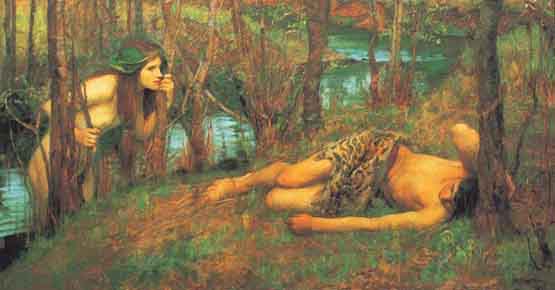
Naiad
In Greek mythology, the Naiads (from the Greek, "to flow," and, "running water") were a type of nymph who presided over fountains, wells, springs, streams, and brooks, as river gods embodied rivers, and some very ancient spirits inhabited the still waters of marshes, ponds and lagoon-lakes, such as pre-Mycenaean Lerna in the Argolid. Naiads were associated with fresh water, as the Oceanids were with saltwater and the Nereids specifically with the Mediterranean; but because the Greeks thought of the world's waters as all one system, which percolated in from the sea in deep cavernous spaces within the bosom of the earth, to rise freshened in seeps and springs, there was some overlap. Arethusa, the nymph of a spring, could make her way through subterranean flows from the Peloponnesus, to surface on the island of Sicily. In his Dionisiaca, (XVI.356; XXIV.123) Nonnus gave the naiads the nonce-name Hydriades ("water ladies").
Otherwise, the essence of a naiad was bound to her spring. If a naiad's body of water dried, she died. Though Walter Burkert points out, "When in the Iliad [xx.4-9] Zeus calls the gods into assembly on Mount Olympus, it is not only the well-known Olympians who come along, but also all the nymphs and all the rivers; Okeanos alone remains at his station," (Burkert 1985), Greek hearers recognized this impossibility as the poet's hyperbole, which proclaimed the universal power of Zeus over the ancient natural world: "the worship of these deities," Burkert confirms, "is limited only by the fact that they are inseparably identified with a specific locality."
They were often the object of archaic local cults, worshipped as essential to fertility and human life. Boys and girls at coming-of-age dedicated their childish locks to the local naiad of the spring. In places like Lerna their waters' ritual cleansings were credited with magical medical properties. Animals were ritually drowned there. Oracles might be sited by ancient springs.
When a mythic king is credited with marrying a naiad and founding a city, Robert Graves offers a sociopolitical reading: the new arriving Hellenes justify their presence by taking to wife the naiad of the spring, so, in the back-story of the myth of Aristaeus, Hypseus, a king of the Lapiths wed Chlidanope, a naiad, who bore him Cyrene. In parallels among the Immortals, the loves and rapes of Zeus, according to Graves' readings, record the supplanting of ancient local cults by Olympian ones (Graves 1955, passim). Aristaeus had more than ordinary mortal experience with the naiads: when his bees died in Thessaly, he went to consult the naiads. His aunt Arethusa invited him below the water's surface, where he was washed with water from a perpetual spring and given advice. A less well-connected mortal might have drowned, being sent as a messenger in this way to gain the advice and favor of the naiads for his people.
Naiads could be dangerous: Hylas of the Argo's crew was lost when he was taken by naiads fascinated by his beauty (illustration, above right). The naiads were also known to exhibit jealous tendencies. Theocritus' story of naiad jealousy was that of a shepherd, Daphnis, who was the lover of Nomia; Daphnis had on several occasions been unfaithful to Nomia and as revenge she permanently blinded him. Salmacis forced the god Hermaphroditus into a carnal embrace and, when he sought to get away, fused with him.
The Naiads were either daughters of Zeus or various Oceanids, but a genealogy for such ancient, ageless creatures is easily overstated. The water nymph associated with particular springs was known all through Europe in places with no direct connection with Greece, surviving in the Celtic wells of northwest Europe that have been rededicated to Saints, and in the medieval Melusine.
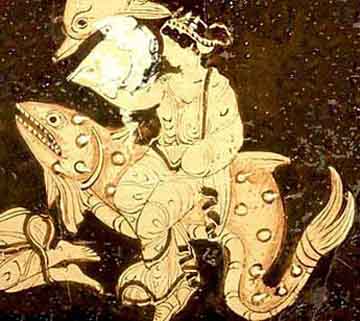
Nereids
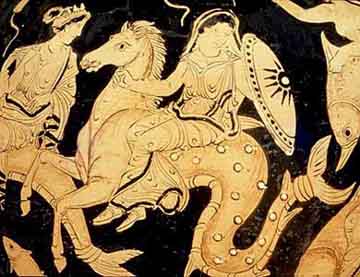
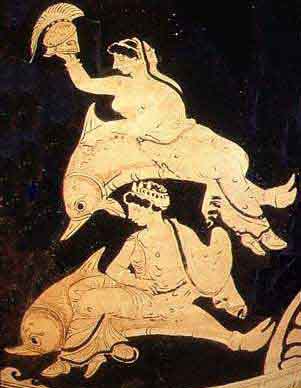
In Greek mythology, the Nereids (neer'-ee-eds) are sea nymphs, the fifty daughters of Nereus and Doris. They often accompany Poseidon and are always friendly and helpful towards sailors fighting perilous storms. They are particularly associated with the Aegean Sea, where they dwelt with their father in the depths within a silvery cave. The most notable of them is Thetis, wife of Peleus and mother of Achilles; Amphitrite, wife of Poseidon; and Galatea, love of the Cyclops Polyphemus. In classical art they are frequently depicted riding an assortment of sea creatures - dolphins, sea monsters, and hippocampi.
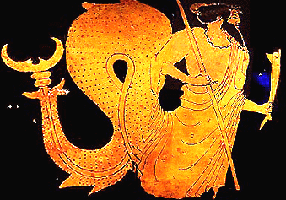
Nereus was an ancient sea god with prophetic powers and the ability to change his shape. Nereus mated with one of the Oceanids (Doris) and became the father of fifty daughters called Nereids [nee're-idz]; three of these are important: Thetis, Galatea and Amphitrite. Nereids are beautiful and often, but not always, depicted as mermaids; and usually they can shange their shape. He was known for his truthfulness and virtue.
Nereus, in Greek Mythology, was the eldest son of Pontus and Gaia, the Sea and the Earth, a Titan who (with Doris) fathered the Nereids, with whom Nereus lived in the Aegean Sea. In the Iliad the Old Man of the Sea is the father of Nereids, though Nereus is not directly named. He was one of the manifestations of the Old Man of the Sea, never more so than when he was described, like Proteus, as a shapeshifter with the power of prophecy, who would aid heroes such as Heracles who managed to catch him even as he changed shapes. Nereus and Proteus ("first") seem to be two manifestations of the god of the sea who was supplanted by Poseidon when Zeus overthrew Cronus. The earliest poet to link Nereus with the labours of Heracles was Pherekydes, according to a scholion on Apollonius of Rhodes.
During the course of the fifth century BCE, Nereus was gradually replaced by Triton, who does not appear in Homer, in the imagery of the struggle between Heracles and the sea-god who had to be restrained in order to deliver his information that was employed by the vase-painters, independent of any literary testimony.
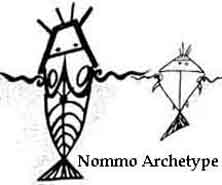
The Nommo are ancestral spirits (sometimes referred to as deities) worshipped by the Dogon tribe of Mali, Africa. The word Nommos is derived from a Dogon word meaning, 'to make one drink'. The Nommos are usually described as amphibious, hermaphroditic, fish-like creatures.
Folk art depictions of the Nommos show creatures with humanoid upper torsos, legs/feet, and a fish-like lower torso and tail. The Nommos are also referred to as Masters of the Water, the Monitors, and "the Teachers. Nommo can be a proper name of an individual, or can refer to the group of spirits as a whole.
Dogon mythology states that Nommo was the first living creature created by the sky god Amma. Shortly after his creation, Nommo underwent a transformation and multiplied into four pairs of twins. One of the twins rebelled against the universal order created by Amma.
To restore order to his creation, Amma sacrificed another of the Nommo progeny, whose body was dismembered and scattered throughout the world. This dispersal of body parts is seen by the Dogon as the source for the proliferation of Binu shrines throughout the Dogons' traditional territory; wherever a body part fell, a shrine was erected.
In the latter part of the 1940's, French anthropologists Marcel Griaule and Germaine Dieterlen (who had been working with the Dogon since 1931) were the recipients of additional, secret mythologies, concerning the Nommo. The Dogon reportedly related to Griaule and Dieterlen a belief that the Nommos were inhabitants of a world circling the star Sirius (see the main article on the Dogon for a discussion of their astronomical knowledge).
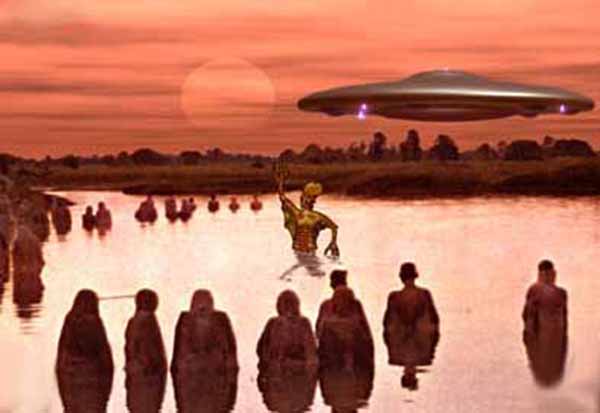
The Nommos descended from the sky in a vessel accompanied by fire and thunder. After arriving, the Nommos created a reservoir of water and subsequently dove into the water. The Dogon legends state that the Nommos required a watery environment in which to live.
According to the myth related to Griaule and Dieterlen: "The Nommo divided his body among men to feed them; that is why it is also said that as the universe "had drunk of his body," the Nommo also made men drink. He gave all his life principles to human beings." The Nommo was crucified on a tree, but was resurrected and returned to his home world. Dogon legend has it that he will return in the future to revisit the Earth in a human form.
The Nommos bear some physical resemblance to several other mythological beings: the Oannes (Babylon), the Enki (Sumeria), Fuxi (China), Dagon (Philistine), and Nereus (Greece), to name a few. It is also interesting to note the motifs common to the story of Nommo with the story of Osiris (dismemberment and the erection of temples at the final resting places of their respective body parts). There are also numerous parallels between the story of Nommo and the traditions of Jesus: both were crucified, both instructed followers to 'drink of my body', and both were associated with the fish
In the 1970's a book by Robert Temple titled The Sirius Mystery popularized the traditions of the Dogon concerning Sirius and the Nommos. In The Sirius Mystery, Temple came to the conclusion that the Dogon's knowledge of astronomy and non-visible cosmic phenomenon could only be explained if said knowledge was imparted upon them by an extraterrestrial race that had visited the Dogon at some point in the past and given them information concerning the cosmos. Temple related this race to the legend of the Nommos and contended that the Nommos were extraterrestrial inhabitants of the Sirius star system who had traveled to earth at some point in the distant past and had imparted knowledge about the Sirius star system as well as our own solar system upon the Dogon tribes.
Some anthropologists studying the Dogon (notably Walter van Beek) found no evidence that they had any historical advanced knowledge of Sirius. Van Beek postulated that Griaule engaged in such leading and forceful questioning of his Dogon sources that new myths were created in the process by confabulation.
Carl Sagan has noted that the first reported association of the Dogon with the knowledge of Sirius as a binary star was in the 1940's, giving the Dogon ample opportunity to gain cosmological knowledge about Sirius and the solar system from more scientifically advanced, terrestrial societies whom they had come in contact with. It has also been pointed out that binary star systems like Sirius are theorized to have a very narrow or non-existent Goldilocks Zone, and thus a high improbability of containing a planet capable of sustaining life (particularly life as dependant on water as the Nommos were reported to be).
It should also be noted that by the 1940's when Marcel Griaule and Germaine Dieterlen recorded the Nommo legends, the Dogon had already come into contact with Islam and Christianity, which could have influenced some of their earlier Nommo traditions, notably those that are similar to Christian traditions concerning Jesus.
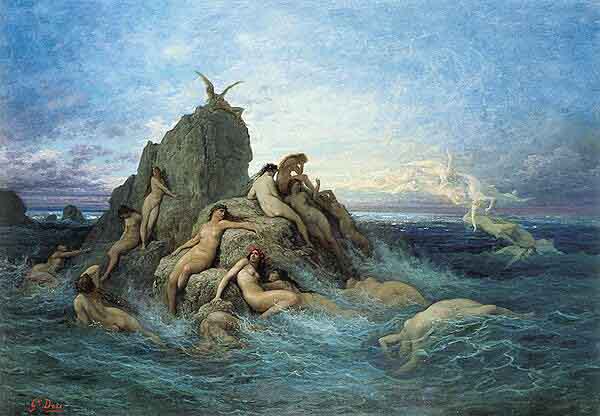
Oceanids
In Greek and Roman mythology, the Oceanids were the three thousand daughters of the Titans Oceanus and Tethys. One of these many daughters was also said to have been the wife of the god Poseidon, typically named as Amphitrite. Each of these nymphs was the patron of a particular spring, river, ocean, lake, pond, pasture, flower or cloud. Oceanus and Tethys also had 3000 sons, the river-gods (Potamoi). Whereas most sources limit the term Oceanids or Oceaniades to the daughters, others include both the sons and daughters under this term.
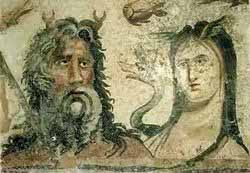
Oceanus
Oceanus was believed to be the world-ocean in classical antiquity, which the ancient Romans and Greeks considered to be an enormous river encircling the world. Strictly speaking, Okeanos was the ocean-stream at the Equator in which floated the habitable hemisphere (oikoumene). In Greek mythology, this world-ocean was personified as a Titan, a son of Uranus and Gaia. In Hellenistic and Roman mosaics, this Titan was often depicted as having the upper body of a muscular man with a long beard and horns, and the lower torso of a serpent (cf. Typhon). On a fragmentary archaic vessel (British Museum 1971.11-1.1) of ca 580 BCE, among the gods arriving at the wedding of Peleus and the sea-nymph Thetis, is a fish-tailed Oceanus, with a fish in one hand and a serpent in the other, gifts of bounty and prophecy. In Roman mosaics he might carry a steering-oar and cradle a ship.
Some scholars believe that Oceanus originally represented all bodies of salt water, including the Mediterranean Sea and the Atlantic Ocean, the two largest bodies known to the ancient Greeks. However, as geography became more accurate, Oceanus came to represent the stranger, more unknown waters of the Atlantic Ocean (also called the "Ocean Sea"), while the newcomer of a later generation, Poseidon, ruled over the Mediterranean.
Oceanus' consort is his sister Tethys, and from their union came the ocean nymphs, also known as the three-thousand Oceanids, and all the rivers of the world, fountains, and lakes. From Cronus, of the race of Titans, the Olympian gods have their birth, and Hera mentions twice in Iliad book xiv her intended journey "to the ends of the generous earth on a visit to Okeanos, whence the gods have risen, and Tethys our mother who brought me up kindly in their own house." In most variations of the war between the Titans and the Olympians, or Titanomachy, Oceanus, along with Prometheus and Themis, did not take the side of his fellow Titans against the Olympians, but instead withdrew from the conflict. In most variations of this myth, Oceanus also refused to side with Cronus in the latter's revolt against their father, Uranus.
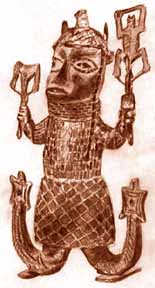
Olokun is experienced in male and female personifications, depending on what region and of West Africa He/She is worshipped. Olokun is personified in several human characteristics; patience, endurance, sternness, observation, meditation, appreciation for history, future visions, and royalty personified. Its characteristics are found and displayed in the depths of the Ocean. Its name means Owner (Olo) of Oceans (Okun).
Olokun is considered the patron orisa of the descendants of Africans that were carried away during the Maafa, or what is sometimes referred to as the Transatlantic Slave Trade or Middle Passage. Olokun works closely with Oya (Deity of Sudden Change)and Egungun (Collective Ancestral Spirits) to herald the way for those that pass to ancestorship, as it plays a critical role in Death (Iku), Life and the transition of human beings and spirits between these two existences.
Olokun also signifies unfathomable wisdom. That is, the instinct that there is something worth knowing, perhaps more than can ever be learned, especially the spiritual sciences that most people spend a lifetime pondering. Olokun also governs material wealth, psychic abilities, dreaming, meditation, mental health and water-based healing.
Olokun is one of many Orisa known to help women that desire children. Olokun also is worshipped by those that seek political and social ascension, which is why heads of state, royalty, entrepreneurs and socialites often turn to Olokun to not only protect their reputations, but propel them further among the ranks of their peers.
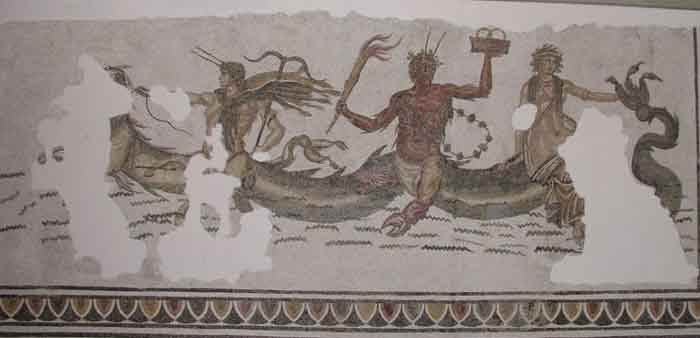
Phorcys
In Greek mythology, Phorcys, or Phorkys was one of the names of the "Old One of the Sea", the primeval sea god, who, according to Hesiod, was the son of Pontus and Gaia. According to the Orphic hymns Phorcys, Cronos and Rhea were the eldest offspring of Oceanus and Tethys (Kerenyi p 42). Other names for the Old Man are Nereus and Proteus (Kerenyi pp 42-43). His wife was Ceto and together they had many children, all hideous monsters (except for the Hesperides) collectively known as the Phorcydes. The Gorgons and Scylla were four of his beautiful children, but they were turned into monsters. In ancient mosaics he was depicted as a fish-tailed merman with crab-claw fore-legs and red.
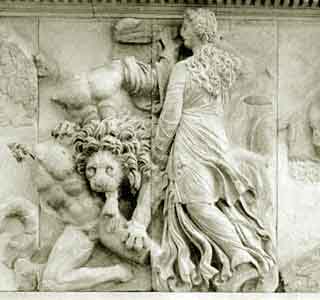
Ceto with Pontus and a lion attacking the Titans
in the Titanomachy from the Pergamon Zeus Altar
In Greek mythology, Pontus (or Pontos, "sea") was an ancient, pre-Olympian sea-god, son of Gaia and Aether, the Earth and the Air. Hesiod (Theogony, line 116) says that Gaia brought forth Pontos out of herself, without coupling. For Hesiod, Pontos seems little more than a personification of Sea. With Gaia, he was the father of the Old Man of the Sea, Nereus and Thaumas (the awe-striking "wonder" of the Sea), of the Sea's dangerous aspects, Phorcys and his sister-consort Ceto, and of the "Strong Goddess" Eurybia. With Thalassa, whose own name simply means "Sea" but in a pre-Greek root, he was the father of the Telchines. Compare the sea-Titan Oceanus, who was more vividly realized than Pontus among the Hellenes.
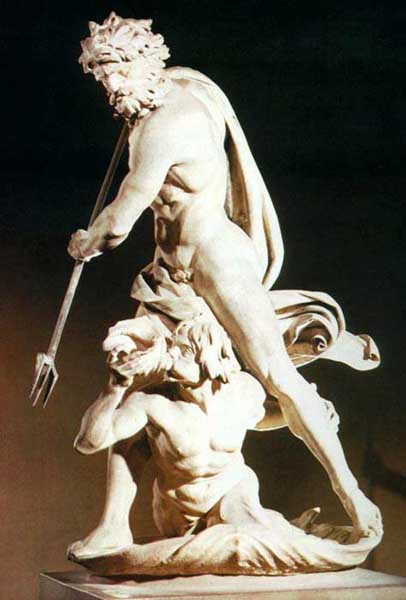
He was Neptune in Roman Mythology
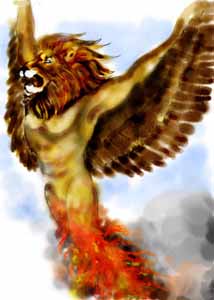
'Proteus' was an ancient sea-god and the herdsman of Poseidon's seals. Like the other sea-gods he had the gift of prophecy and the ability to change his shape at will. He used to rest in caves to 'shelter from the heat of the Sirius. He was a son of Neptune and subject to thesea god Poseidon, and his dwelling place was either the island of Pharos, near the mouth of the Nile River, or the island of Carpathus, between Crete and Rhodes. He knew all things--past, present, and future--but would not share his knowledge unless compelled by a captur who could restrain the God--no matter what forms he might assume.
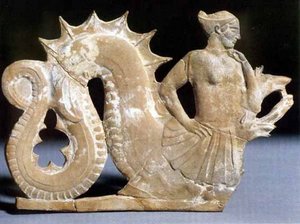
Scylla is one of the two sea monsters in Greek mythology (the other being Charybdis) which lives on one side of a narrow channel of water. The two sides of the strait are within an arrow's range of each other, so close that sailors attempting to avoid Charybdis will pass too close to Scylla and vice versa. The phrase between Scylla and Charybdis has come to mean being in a state where one is between two dangers and moving away from one will cause you to be in danger from the other.
Traditionally the aforementioned strait has been associated with the Strait of Messina between Italy and Sicily but more recently this theory has been challenged and the alternative location of Cape Skilla in north west Greece suggested.
Scylla has the face and torso of a woman, but from her flanks grow six long necks equipped with dog heads, each of which contained three rows of sharp teeth. Her body consisted of twelve canine legs and a fish's tail. She was one of the children of Phorcys and either Hecate, Crataeis, Lamia or Ceto (where Scylla would also be known as one of the Phorcydes).
In Greek mythology, Ceto, or Keto (Greek: "sea monster") was a hideous aquatic monster, a daughter of Gaia and Pontus. The asteroid (65489) Ceto is named after her, and its satellite (65489) Ceto I Phorcys after her husband. She was the personification of the dangers of the sea, unknown terrors and bizarre creatures. Eventually, the word "ceto" became simple shorthand for any sea monster. It is still used in this way - cetacean is a derivation. Her husband was Phorcys and they had many children, collectively known as the Phorcydes or Phorcydides. In Greek art Ceto was drawn as a serpentine fish. Ceto also gave name to the constellation Cetus.
In Homer's Odyssey, Odysseus is given advice by Circe to sail closer to Scylla, for Charybdis could drown his whole ship. Odysseus then successfully navigates his ship past Scylla and Charybdis, but Scylla manages to catch six of his men, devouring them alive.As retold by Thomas Bulfinch, Scylla was originally a beautiful nymph.
She scorned her many suitors and chose to live among the Nereids instead, until one day Glaucus saw and fell in love with her. Glaucus was a mortal fisherman who had previously been transformed by chewing a plant, gaining the form of a fish from his waist down. When Glaucus declared his love to Scylla she fled, taking him for a monster.
Glaucus sought the help of Circe, hoping that this witch could make Scylla to love him with her herbs, but Circe fell in love with Glaucus herself and asked him to forget Scylla. Glaucus rejected her request, declaring that his love for Scylla was eternal.Circe was enraged by Glaucus' refusal, and turned her anger on the girl whom he loved.
She went and poisoned the water which Scylla used to bathe with her magical herbs. When Scylla waded into the water, the submerged half of her body was transformed into a combination of fish joined with six ferocious dogs' heads sprouting from around her waist.
The dogs attacked and devoured anyone who came near, beyond her ability to control, and Scylla fled to the shore of the strait to live there alone.It is said that by the time Aeneas' fleet came through the strait after the fall of Troy, Scylla had been changed into a dangerous rock outcropping which still stands there to this day. Scylla and Charybdis are believed to have been the entities from which the term, "Between a rock and a hard place" (ie: a difficult place) originated.
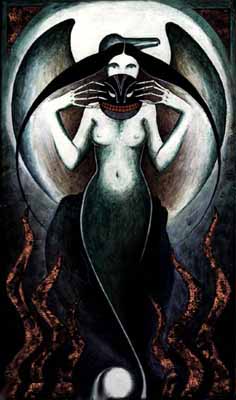
In Inuit mythology, Sedna is a sea goddess and master of the animals, especially mammals such as seals, of the ocean. She lives in Adlivun, the Inuit underworld. Sedna is also known as Arnakuagsak or Arnarquagssaq (Greenland) and Nerrivik or Nuliajuk (Alaskan). According to myth, Sedna was the daughter of the creator-god Anguta and his wife. She is said to have been so huge and hungry that she ate everything in her parents' home, and even gnawed off one of her father's arms as he slept. According to some versions of the myth, she took a dog for her husband. Anguta was so angry that he threw her over the side of his canoe. She clung to its sides, whereupon he chopped her fingers off one by one until she let go. She sank to the underworld, becoming the queen of the monsters of the deep, and her huge fingers became the seals, sea-lions and whales hunted by the Inuit.
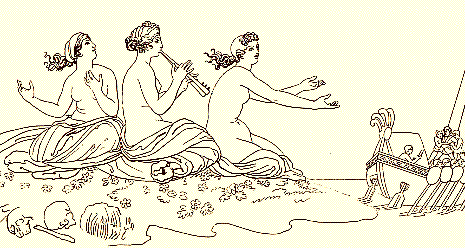
Sirens
The Sirens of Greek mythology are sometimes portrayed in later folklore as fully aquatic and mermaid-like; the facts that in Spanish, French, Italian, Polish, Romanian and Portuguese the word for mermaid is respectively Sirena, Sirene, Sirena, Syrena, Sirena and Sereia, and that in biology the Sirenia comprise an order of fully aquatic mammals that includes the dugong and manatee, add to the visual confusion, so that Sirens are even represented as mermaids. However, "the sirens, though they sing to mariners, are not sea-maidens," Harrison had cautioned; "they dwell on an island in a flowery meadow."

In Greek mythology, silver-footed Thetis is a sea nymph, one of the fifty Nereids, daughters of "the ancient one of the seas," Nereus, and Doris (Hesiod, Theogony), a grand-daughter of Tethys. While most extant material about Thetis concerns her role as mother of Achilles, and while she is largely a creature of poetic fancy rather than cult worship in the historical period, with one exception, a few fragmentary hints and references suggest an older layer of the tradition, in which the sea-goddess Thetis played a far more central role in the religious practices and imagination of certain Greeks. The pre-modern etymology of her name, from tithemi, "to set up, establish", suggests the perception among Classical Greeks of an early political role. Walter Burkert considers her name a transformed doublet of Tethys.
Quintus of Smyrna, recalling this passage, does write that Thetis once released Zeus from chains; but there is no other reference to this rebellion among the Olympians, and some readers, like M.M. Willcock, have understood the episode as an ad hoc invention of Homer's to support Achilles' request that his mother intervene with Zeus. Laura Slatkin explores the apparent contradiction, in that the immediate presentation of Thetis in the Iliad is as a helpless minor goddess overcome by grief and lamenting to her Nereid sisters, and links the goddess's present and past through her grief. She draws comparisons with Thetis' role in another work of the epic Cycle concerning Troy, the lost Aethiopis, which presents a strikingly similar relationship that of the divine Dawn, Eos, with her slain son Memnon; she supplements the parallels with images from the repertory of archaic vase-painters, where Eros and Thetis flank the symmetrical opposed heroes. Thetis does not need to appeal to Zeus for immortality for her son, but snatches him away to the White Island Leuke in the Black Sea, an alternate Elysium where he has transcended death, and where an Achilles cult lingered into historic times.

Triton is a mythological Greek god, the messenger of the deep. He is the son of Poseidon, god of the sea, and Amphitrite, goddess of the sea. He is usually represented as a merman, having the upper body of a human and the tail of a fish.
Like his father, he carried a trident. However, Triton's special attribute was a twisted conch shell, on which he blew like a trumpet to calm or raise the waves. Its sound was so terrible, that when loudly blown, it put the giants to flight, who imagined it to be the roar of a mighty wild beast (Hyginus, Poet. astronom. ii. 23). According to Hesiod's Theogony, Triton dwelt with his parents in a golden palace in the depths of the sea. The story of the Argonauts places his home on the coast of Libya. When the Argo was driven ashore on the Lesser Syrtes, the crew carried the vessel to Lake Tritonis, whence Triton, the local deity, guided them across to the Mediterranean (Apollonius Rhodius iv. 1552).
Triton was the father of Pallas and foster parent to the goddess Athena. Pallas was killed by Athena during a fight between the two goddesses. Triton is also sometimes cited as the father of Scylla by Lamia. Triton also appeared in Roman myths and epics. In the Aeneid, Misenus, the trumpeter of Aeneas, challenged Triton to a contest of trumpeting. The god flung him into the sea for his arrogance.
Over time, Triton's name and image came to be associated with a class of merman-like creatures, the Tritons, which could be male or female, and usually formed the escort of marine divinities. Ordinary Tritons were described in detail by the geographer Pausanias (ix. 21). A variety of Triton, the Centauro-Triton or Ichthyocentaur ("Fish-centaur"), was described as having the forefeet of a horse in addition to the human body and the fish tail. It is probable that the idea of Triton owes its origin to the Phoenician fish-deities.
Among the things named after Triton include Triton, the largest moon of the planet Neptune. This name is symbolic, as Neptune is the Roman name for Triton's father. Triton is also associated in industry with tough, hard wearing machines such as Ford's Triton Engines and Mitsubishi's Triton pickup trucks.
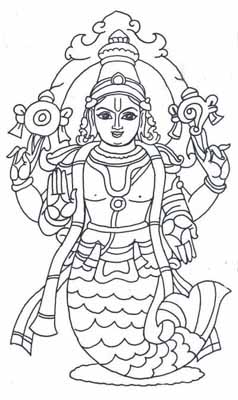
who call it the Mark of Vishnu a god-man who was half-man, half-fish.
Avatars
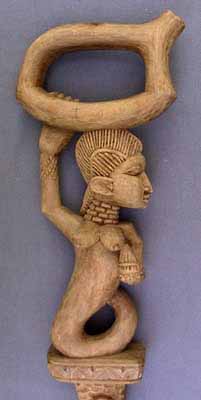
In Yoruba mythology, Yemoja is a mother goddess; patron deity of women, especially pregnant women; and the Ogun river (the waters of which are said to cure infertility). Her parents are Oduduwa and Obatala. She had one son, Orungan, who raped her successfully one time and attempted a second time; she exploded instead, and fifteen Orishas came forth from her. They include Ogun, Olokun, Shopona and Shango.Yemoja is also venerated in Vodun. Among the Umbandists, Yemoja is a goddess of the ocean and patron deity of the survivors of shipwrecks. In Santeria, Yemoja is the equivalent of Our Lady of Regla.